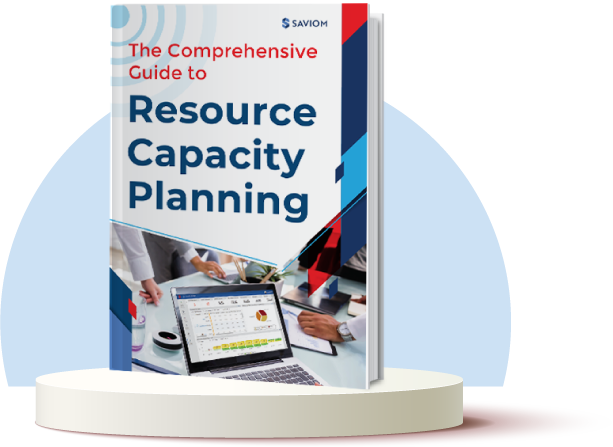“Great vision without great people is irrelevant.” – Jim Collins
All businesses, regardless of size, need the right talent to stay competitive amid market volatility and enhance their business profitability. The same holds true for professional services firms as well.
An efficient workforce is imperative for controlling resourcing costs, driving profitability, embracing agility, and preparing for the future.
Despite this, service firms often fail to implement measures to plan, retain, and optimize their human resources. This results in widening skill gaps, reduced profit margins, and lost business opportunities.
Therefore, firms should design a systematic workforce planning process that helps meet their long-term business goals, streamlines day-to-day operations, improves service delivery, and more.
This blog emphasizes the critical benefits of workforce planning in professional service firms.
Let’s begin.
Why is workforce planning crucial in professional services?
According to an IDC study, the market for digital transformation in professional services is forecast to reach approx. $400 billion by 2027.
Professional service firms are undergoing rapid changes due to globalization and emerging technologies such as AI, ML, blockchain, etc. It has enabled PS firms to diversify their services and venture into newer markets to accommodate ever-changing client requirements. Therefore, it is imperative to implement a strategic workforce plan to ensure the availability of a skilled workforce to meet these changing demands.
For instance, if a marketing services firm intends to expand globally in the next 6-7 years, it needs to consider technology-enabled market changes and skill requirements that satisfy its future requirements. With proper workforce planning, they will be able to identify the talent demands and future-proof their workforce with appropriate technical training and upskilling opportunities.
Additionally, the transformation of the business market has led to increased global competition and service proliferation. As a result, PSOs must provide high-quality services at a lower cost. With a proper workforce plan, PSOs can identify skilled cost-effective consultants to deliver these services. In addition, it also helps PS firms to stay forewarned and mitigate resource-related risks such as talent shortage, high turnover, etc., due to constantly changing demands in a competitive and volatile market.
For example, a law firm experiences a surge in demand for bankruptcy attorneys at the start of the year, particularly during the week before tax filing. With a robust workforce plan, law firms can hire on-demand professionals in advance to prepare for the peak season and complete projects on time and within budget.
Thus, in a market characterized by constant evolution and uncertainty, workforce planning prepares PS firms to have the control and visibility they need to deal with the ever-changing market and adapt to future challenges.
Now having learned about the basics of workforce planning in PS firms, let’s dig deeper to understand the benefits.
Benefits of workforce planning in professional services firms
Workforce planning offers myriads of benefits to professional service organizations, which helps them enhance their profitability. Here are a few significant ones –
Reduces resourcing costs with the right mix of consultants
Professional services firms leverage many generalists and specialized resources like consultants, analysts, actuaries, associates, etc., to generate revenue. As a result, identifying the right talent for the right cost becomes critical to maintain profitability. With workforce planning, organizations can analyze the immediate skill requirements and determine whether they are one-time or recurring.
Based on that, managers can recruit permanent and contingent consultants or create a judicious mix of both. For example, an audit and accounting firm can leverage a skilled junior financial analyst to work on a two-month-long tax project instead of a senior analyst. This reduces the consultant cost significantly, thereby ensuring the successful delivery of the projects within budget.
Read More: What is a Contingent Workforce and Why an Organization Needs It
Helps maintain workforce competency matrix in real-time
For a professional services firm to scale new heights, consulting managers must understand the practitioners’ current capabilities and skills. However, if the workforce’s competency exists in silos or is unavailable in real-time, managers may struggle to find the right consultant within the organization. Further, this can lead to data duplication and double bookings, causing scheduling conflicts.
Through workforce planning, PSOs can leverage a centralized competency matrix to capture, update and verify the core competencies of the consultants. This enables the consulting managers to easily search for specific skills within the team and assess if they have the technical proficiency required for specific projects. Thus, it helps in enhancing organizational efficiency and improving the bottom line.
Bridges consultants’ capacity vs demand gaps
When professional service firms foresee the resource requirements at the eleventh hour, it leads to last-minute firefighting and increases the hiring cost, resulting in schedule and budget overruns. Therefore, managers have to forecast the demand for pipeline projects, estimate consultant requirements, and take appropriate steps to mitigate gaps.
For example, a construction firm hired workers in bulk for an ongoing project, and after their work was completed, they were quickly released. Following this, supervisors can sell this excess capacity of workers at a discounted price, adjust project timelines, or redeploy them to other tasks. Conversely, in case of a shortage, supervisors can hire or train existing workers. Thus, proactively forecasting and bridging the gap eliminates the chances of last-minute hiring hassle and unnecessary cost escalations.
Read More: Benefits of Capacity Planning in Professional Services Companies
Streamlines planning for seasonal and market fluctuations
Professional service firms frequently experience an increase in workforce demand during seasonal and market fluctuations. Therefore, understanding daily operations and forecasting seasonal demands can help consulting managers build an on-demand contingent workforce. In addition, it will help them handle seasonal peaks and troughs effectively without increasing the project’s cost. This way, companies can streamline labor planning and reduce administrative overheads.
For instance, a marketing firm experiences a sudden peak in promotional and sales activity during a product launch at the end of the year. Through workforce planning, marketing managers can predict the rise in the demand for different roles and hire freelance graphic designers, content writers, sales marketers, etc. This will help significantly reduce the resource cost without compromising the quality, ensuring high client satisfaction and profitability.
Identifies the right practitioners for stretch assignments
Over the last few years, assigning stretch assignments has gained momentum in PS firms as they offer consultants a unique opportunity to broaden their skillsets and competencies. Further, it paves the way for resources to grow by improving their billability. Therefore, determining the right people to assign these stretch assignments is crucial.
Through workforce planning, managers can identify the right practitioners for stretch assignments to diversify their existing skills. For example, in an IT Consultancy firm, managers assign an HTML developer the task of learning Java language and building an app. If the developer succeeds, the PS firm can consider them for diverse projects and promotions. Additionally, this on-the-job training will increase their engagement and productivity, thus enhancing employee performance.
Helps create retention strategy for new joiners
According to a survey, “between 10 and 25 percent of new hires leave within the first six months of hiring.”
It is important to create a good impression with the new hires so that they can take up assignments quickly and develop a sense of belonging to the organization. If the first impression is not up to the mark, many consultants can leave within a few months of joining. Efficient workforce planning guides PSOs in building a long-term retention strategy by establishing an engaging onboarding process for new hires.
It helps assign individual mentors to these new hires, familiarize them with the organizational structure, and expedite the address of their queries. Furthermore, managers can provide them with diverse work opportunities and facilitate training and upskilling programs to hone their skills. In addition, associates must also be given timely constructive feedback and be compensated as per the market standards. This will increase their engagement, motivate and effectively retain them.
Read More: 7 Effective Strategies to Reduce Attrition in Professional Services Firms
Future-proofs consultants’ skill-sets for emerging technologies
According to estimates, by 2030, nearly 20% of the workforce will be significantly under-skilled for their jobs
Due to emerging technologies like AI, ML, and automation, numerous PSOs require professionals with extensive knowledge in analytics and data science. In addition, when consultants fail to update their skills regularly, it leads to obsolescence. A robust workforce planning provides firms with a road map for consultants to diversify and update their knowledge through various programs like IDPs, training/upskilling, etc.
Additionally, it encourages organizations to implement learning methods, such as peer-to-peer coaching, reverse mentoring, shadowing, etc., for each consultant. This will prepare the workforce to take on multi-faceted projects in the future and boost their efficiency and effectiveness. Further, these initiatives will help bridge their skill gaps, improve performance, future-proof the workforce and enable PSOs to stay relevant in the digital age.
Read More: How Can Retraining/Upskilling Future-Proof Your Workforce?
Facilitates succession planning for critical consultants
Succession planning is a process of talent management that helps create a skilled workforce capable of filling leadership and other critical roles as the business grows or changes. However, when a PS firm lacks succession planning, important projects can halt due to a shortage of critical consultants, causing revenue losses and negative client experiences.
Strategic workforce planning aids PSOs in identifying top performers across all departments and helps enforce best practices to train and promote them to critical positions. It also enables PS firms to offer consultants mentoring, technical and soft skills training and shadowing opportunities to advance their knowledge. This ensures smooth business continuation as well as prepares them for future undertakings.
Aids intraday management of PS firms
Intraday management is the workforce planning process that monitors workload and adjusts schedules as required. It allows managers to respond to rapidly changing situations and ensure that the consultants and projects stay on track in the long run. In addition, by revising the workforce plan regularly, managers can ensure that consultants work as per the timeline and that the demand matches the forecast value.
For instance, a marketing firm lands a critical project at the final hour, and the deadline is approaching. Through intraday management, the firm can reduce the impact of this unanticipated workload by reassigning professionals. Further, the firm will be able to streamline the peaks and troughs by tracking daily workflows, ensuring dependable performance and superior client service.
Considering the advantages of workforce planning in professional services firms, let’s look at how resource management software can help.
How can a futuristic workforce planning tool help professional service firms?
An advanced workforce planning software enables professional services firms to create an optimized workforce.
Here’s how-
- The centralized visibility of the tool offers foresight into the pipeline consulting project resource demand. Accordingly, managers can streamline the workforce planning processes by analyzing the existing talent’s current and future capabilities.
- Moreover, firms can maintain a competency matrix to check various resource attributes like skill sets, competencies, certifications, availability, cost, location, etc., in real-time.
- Also, using the tool’s capacity vs demand report, PS firms can identify gaps and overcome capacity problems ahead of time. Thereby avoiding last-minute hiring and costly hiring/firing cycles.
- Further, the color-coded heatmaps help identify under/overutilized resources. Managers can thereby implement appropriate optimization techniques to optimize consultants’ utilization levels.
- Additionally, the tool offers real-time reports on various resource indicators such as forecast vs actual, availability, project vacancy, and people on the bench reports for improved business decisions. The forecast financial reports enable tracking financial variances and taking remedial steps to reduce resourcing costs.
- Last but not least, the modeling and simulation technique lets firms explore the potential effects of different scenarios in a sandbox environment. The consulting managers can then analyze and compare the outcomes of each scenario and select the best-fit plan.
Conclusion
Effective workforce planning is crucial for PS firms’ sustainability and profitability. It plays a vital role in keeping the organization future-ready and competitive amidst the volatile and uncertain market. However, it is only possible to attain the above benefits when firms use the right workforce planning tool to help identify and mitigate bottlenecks. This will also help leverage the maximum resource potential for higher productivity and business efficiency.
So, are you ready to create an efficient workforce plan in your firm and reap these benefits?
The SAVIOM Solution
SAVIOM is the market leader in helping multinational clients manage their resources efficiently and effectively. With over 20 years of experience, this Australian-based MNC has a global presence across 50 countries and has helped 100+ clients with their Workforce Planning Software. Saviom also provides tools for Enterprise Project Resource Management, Project Portfolio Management, and Professional Service Automation.










